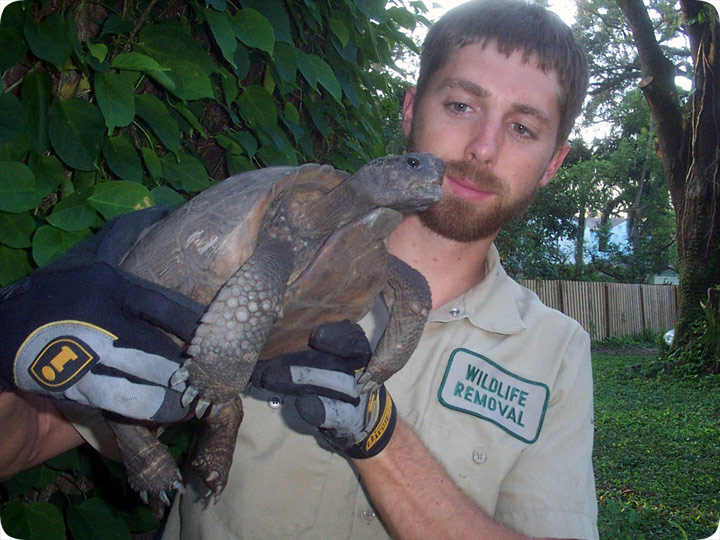-
info@aaanimalcontrol.com
Call us for help in your town
Humane Wildlife Education
Florida Gopher Tortoise

09.18.2004 - I simply found and photographed and then released this fine specimen. The Florida Gopher Tortoise, Gopherus polyphemus is, like most torti, slow. However, unlike most tortoises, it can dig really f'ing well. It digs these amazing
burrows, which are like, fifteen feet deep or more. Several wildlife species, such as the rare Indigo Snake, use these burrows for refuge. Unfortunately, the Gopher Tortoise is in trouble. As usual, habitat loss is the problem. There's a lot of land development
here in Florida, and much of their habitat is bulldozed. In addition, this slow animal often falls victim to car collisions. It reproduces slowly, so the population probably won't recover well.
This doesn't bode well for the endangered Florida Gopher Tortoise or the other animals that use the burrows. It's too bad. I think that this turtle is pretty cool. I like digging animals. They're tough. I like to dig. Well, not much else to say, I guess.
Do it yourself: Visit my How To Get Rid of Turtles page for tips and advice.
Get professional help: Visit my Nationwide Pro Directory of wildlife removal experts.
For more wildlife stories, click my Wildlife Blog
or click my below banner to hire a local trapper.
There are many beautiful animals native to the Florida sun and land, favored for its lush plant-life, which helps the creatures thrive. Gopher tortoises are no exception, being native to dry-land, and relatively well-drained sandy soil spaces. These are usually associated with longleaf pine and dry oak sand hill locations, where they are most common. They can even be found in some areas where their habitat has been disturbed, like at road-side areas and surrounding power-line areas. They are good survivors and persistent animals and it's for that reason. These animals are protected by federal law under the endangered species act, so should be protected by anyone who comes across them, or left to their own vices.
Gopher tortoises can grow to be about 15 inches long, and 15 pounds in weight. They have strong back legs, and front feet specialized for digging and burrowing. Burrows protect them from predators, and while they're most active in summer, they spend most of their time in burrows. Many burrows can be dug in a single year and can vary from 3 feet to 52 feet, and 9 to 23 feet deep. These animals mostly eat greens, like grasses, mushrooms, berries, and so on. They live well up to 80 years in the wild, and over 100 years in captivity. They're slow, developing sexual maturity around 20 years after birth. They hatch their eggs close to the entrances of their burrows, in order to gather heat, which helps other animals like opossums come to steal them quickly.
The threats that gopher turtles face are quite many, supporting the reason why they are on the endangered list. The destruction of their habitats comes as a significant threat, like fragmentation, degradation, and predation. The inadequacy of their regulatory mechanisms makes them scarce, and the incompatibility of developed herbicides used on land is at the cost of their health. In order for gopher tortoises to thrive, they require large spaces of land (by roads, buildings, etc.). This is becoming more scarce, and the reduction of natural land reduces their possible food sources too. Roadkill is one of the leading factors of death in all tortoises, and although removing them from their homes is illegal, many people continue to kill and eat them, or capture them.
Many homeowners can do their bit to help gopher tortoises, simply by doing nothing. When you see them pass, admire them, and then leave them to themselves, as it plays a better part in keeping nature as it intends to be. Sparser lands are more helpful for the tortoise to thrive, and as it faces more threats, it needs all the help it can get.




















